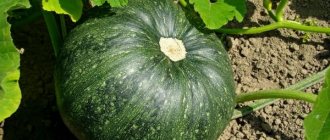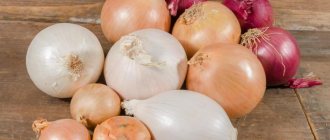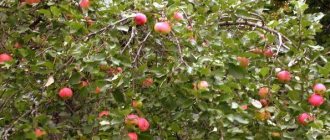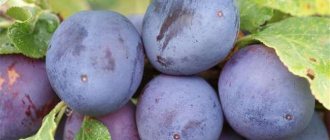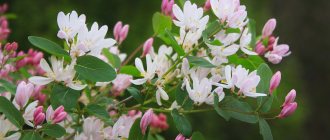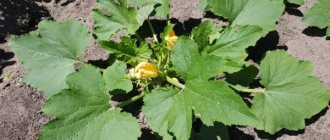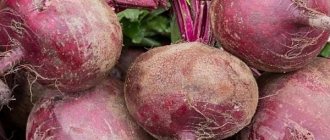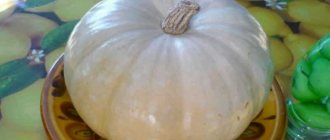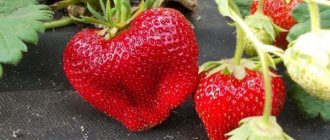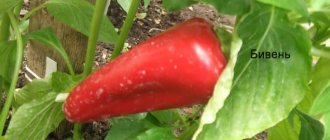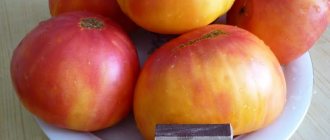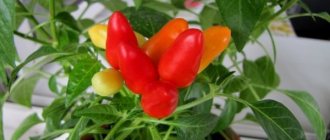The varietal diversity of this vegetable crop is amazing - Squash, Arabat pumpkin, Butternut and dozens of other names. With different shapes, sizes, colors and tastes, this vegetable will please everyone. Gardeners can choose those varieties of pumpkin that meet the characteristics of their site and taste preferences. Which pumpkin variety is the sweetest, how to choose a variety based on the characteristics of the growing location? Bush pumpkin is suitable for cultivation in a country garden.
This article presents the reader with the most popular varieties of pumpkin, a brief description and photo of each variety. This information will help gardeners and summer residents grow this wonderful vitamin-rich vegetable in their garden.
With a hard crust
As the name implies, vegetables have a denser skin, which makes them resistant to damage and suitable for long-term transportation.
Olga
What is interesting about the variety:
- Form. Oval, elongated.
- Weight. They reach only 4-7 kg.
- Color. The skin has an interesting green-yellow color that looks like stripes. Creamy inside. It is noteworthy that the pumpkin seeds are dark green, almost black.
- Pulp. The taste develops more strongly a few days after collection.
- Resistance to parasites and diseases. Increased.
- Growing season. Can be collected after 120 days.
Pumpkin seeds do not have a shell, so the variety is classified as a gymnosperm.
Bun
Main parameters:
- Form. Round, with weakly expressed segmentation.
- Weight. Very small, only 1.5 kg.
- Color. The outside of the pumpkin is bright orange, sometimes with small white stripes.
- Pulp. Useful for baby and dietary nutrition.
- Resistance to parasites and diseases. Average.
- Growing season. Harvest time occurs 90 days after planting.
Lady's nail
Character traits:
- Form. Oval, round, looks like a melon, but without the characteristic mesh.
- Weight. Does not exceed 5 kg.
- Color. The skin is grayish or yellow, the flesh is a shade more tender.
- Pulp. Quite tasty. But more often grown for seeds.
- Resistance to parasites and diseases. Average.
- Growing season. Ripens in 95-105 days.
For the northwest
If you are going to grow pumpkin in the north-west of Russia, then you should choose the following varieties of pumpkin:
- Bush orange. Early ripening variety. The fruits are spherical and have a bright orange color. The weight of the pumpkin reaches 4-5 kg. The pulp is yellow in color and contains a large amount of sugars and dry matter. The main advantage of this variety remains high productivity and early ripening.
- In the conditions of the north-west, an excellent option would be to use varieties such as Troyanda and Prikornevaya. They have a fast ripening period and high yield. The fruits are all 4.5 - 7 kg. The core has excellent taste and is presented in an orange-yellow color scheme. The varieties have strong immunity to common diseases. The fruits retain their taste and presentation over a long period of storage.
- Bush. This variety is in great demand among gardeners and gardeners. Characterized by small fruits. Ripening period is early. The plant develops in the form of a bush. Fruit weight is 1.5-2 kg, yellow-green in color. The pulp is yellow, juicy and tasty.
For cereals
It is believed that the most delicious porridge comes from starchy, not too juicy varieties. The flesh of these pumpkins is crispy, slightly dry, but not very fibrous.
Zorka
What is the difference:
- Form. Round, slightly elongated, with dimly defined segments.
- Weight. Is about 7 kg.
- Color. Greenish-gray with orange spots. Inside is a bright orange hue.
- Pulp. Dense, not very juicy, but pleasant to the taste. Contains many vitamins.
- Resistance to parasites and diseases. Average.
- Growing season. You can harvest in just 110 days.
Granddaughter
Peculiarities:
- Form. Round, slightly flattened, with a rough surface.
- Weight. About 2-3 kg.
- Color. Greenish or orange, there are mixed varieties. Yellowish inside.
- Pulp. Dense, starchy, with a nutty flavor.
- Resistance to parasites and diseases. Increased.
- Growing season. It takes 105-110 days to ripen.
Smile
About the variety:
- Form. Spherical, slightly flattened at the top and bottom, neat.
- Weight. A very small variety, pumpkins grow up to about 700 g, sometimes up to 1 kg.
- Color. The skin is orange, with thin light stripes. The inside of the pumpkin is orange.
- Pulp. The fruits are sweet, aromatic, but not very juicy.
- Resistance to parasites and diseases. High. They are only susceptible to rotting.
- Growing season. Ripens quickly, in just 80 days.
Wax gourd (Benincasa hispida)
Elongated green pumpkins of this species were originally known only in the Southeast.
But today the first varieties of pumpkin of the genus Benincasa hispida have appeared in Russia. The fruits are dark green in color and have an unusual dense bark that feels like wax. The Chengzhou wax gourd variety produces fruits that are ready for harvest 125-130 days after sowing. Pumpkins ripen on long powerful vines. The weight of each fruit reaches 6–15 kg, and its length ranges from 25 to 50 cm.
The milky pulp of this type of pumpkin can be used boiled, stewed or fried. Both green pumpkins that have not reached ripeness and ripe fruits are used for culinary purposes. As the pumpkin ripens, it accumulates some sugar, but it cannot compare with butternut squash. But wax pumpkin holds the record for shelf life. Without loss of quality, fruits can last up to 2–3 years.
Useful tips for choosing a pumpkin - video
Feed
Grown as food for livestock. Pumpkins are made into silage or fed raw.
hundred pound
Among the parameters:
- Form. Round, with pronounced segments.
- Weight. Reaches 20 kg.
- Color. Bright orange, creamy yellow inside.
- Pulp. The pumpkin is sweetish and has loose contents.
- Resistance to parasites and diseases. Good.
- Growing season. It takes about 120 days to ripen.
Basal
Peculiarities:
- Form. Round, smooth surface.
- Weight. Within 10 kg.
- Color. Externally gray, with a mesh pattern. The inside is bright orange.
- Pulp. Dense, with a lot of juice.
- Resistance to parasites and diseases. Average.
- Growing season. The fruits reach maturity in 110 days.
Hybrids
Varieties of this category were bred in the laboratory by crossing 2 or more varieties. They have a more pronounced taste and good stability.
Rosy plump F1
What is it valued for:
- Form. Round, with clearly distinguishable segments.
- Weight. Reaches 8 kg.
- Color. The pumpkin is orange with a hint of pink on the outside, but brighter on the inside.
- Pulp. Full of juice and sweetness.
- Resistance to parasites and diseases. Average.
- Growing season. It will take up to 100 days for the fruits to ripen.
Matilda F1
What to pay attention to:
- Form. Oblong at the top and widened at the bottom.
- Weight. Small, up to 3 kg.
- Color. The skin is light orange, yellowish or almost white, with an orange color inside.
- Pulp. The fruits are juicy, aromatic, sweet.
- Resistance to parasites and diseases. Average.
- Growing season. You need to wait 115 days after germination before harvesting.
Hazelnut F1
How to distinguish:
- Form. Round, with a smooth surface.
- Weight. Does not exceed 2 kg.
- Color. Bright orange, with barely noticeable greenish stripes. The inside of the pumpkin is yellowish.
- Pulp. It is considered not sweet and juicy enough.
- Resistance to parasites and diseases. The plant needs good additional protection.
- Growing season. It takes about 90 days to ripen.
Muscat
Varieties of this type were first obtained in the south, in Mexico. It is considered one of the most popular varieties of pumpkin due to its pleasant nutmeg aroma and long shelf life.
Spanish guitar
What to pay attention to:
- Form. Reminds me of the musical instrument of the same name. Elongated at the top with a slight thickening towards the bottom.
- Weight. Usually no more than 8 kg.
- Color. The outside is soft orange, with shades of gray, the inside is brighter.
- Pulp. The taste is unusual, with notes of apricot.
- Resistance to parasites and diseases. Requires additional protective measures.
- Growing season. The ripening period varies within 100 days.
Muscat de Provence
What are the characteristics:
- Form. Flattened inside, with rounded edges and pronounced segments.
- Weight. Not very large, up to 4 kg.
- Color. Brown, with a slight almond tint. Orange inside.
- Pulp. Full of juice and sweetness.
- Resistance to parasites and diseases. Average.
- Growing season. Ripening can take up to 110 days.
Walnut
How to distinguish:
- Form. Reminds me of a pear. Elongated at the top with thickening towards the bottom.
- Weight. The fruits are small, up to 2 kg.
- Color. The skin is light orange, with thin green stripes near the stalk. Inside the shade is more saturated, with a yellowish cut of the skin.
- Pulp. It has a pleasant taste with hints of nuts.
- Resistance to parasites and diseases. Low.
- Growing season. It takes 90-110 days to obtain a harvest.
Varieties of pumpkins with large fruits
Many gardeners strive to grow a truly gigantic vegetable. There are many record holders among representatives of this culture. To achieve your cherished goal, it is not enough to properly care for the plant. A prerequisite for success is a correctly selected variety that produces large fruits.
Large-fruited types of pumpkin:
- Flashlight;
- Titanium;
- Centner;
- Atlantic giant;
- Fatty;
- Parisian gold;
- Russian porridge.
Pumpkin lantern
The average weight of one fruit of this selection variety is approximately 6 kg. With proper care and feeding, you can get larger specimens. The variety has a long shelf life. Juicy, crispy flesh is hidden under a fairly thin skin.
Russian porridge
Table variety, distinguished by large fruits. The average weight of a pumpkin reaches 7 kg. The fruits are round, bright orange with a slight pink tint.
Characteristic:
- mid-season;
- Up to 4 fruits ripen on one plant;
- the pulp has a pleasant aroma and balanced taste;
- used in cooking for preparing side dishes, soups, and cereals.
With an unusual taste
The varieties presented below have unusual taste characteristics.
Marina from Chioggia
What makes it special:
- Form. Slightly flattened, covered on the outside with growths resembling warts.
- Weight. Available within 12 kg.
- Color. Rich, poisonous green. Bright yellow inside.
- Pulp. It has a very interesting taste of hazelnuts and sweet exotic fruits.
- Resistance to parasites and diseases. High.
- Growing season. The harvest is harvested 130 days after germination.
Other names for the variety are “Sea Monster” and “Frog Princess”.
Pastille champagne
What's unusual:
- Form. Reminds me of zucchini. Oval, oblong, with indistinct lines of segments.
- Weight. It fluctuates between 2.5-3.5 kg.
- Color. The skin is orange-pink, with a hint of green. The inside of the pumpkin is yellowish.
- Pulp. It has a vanilla aroma and a light melon flavor.
- Resistance to parasites and diseases. Average.
- Growing season. It takes 90 days for pumpkins to fully ripen.
Reviews from summer residents
Most gardeners prefer to grow beautiful and juicy pear-shaped pumpkins. Many are attracted by the classic orange color and melon aroma. However, sometimes expectations are not met: instead of large and attractive fruits, small and watery pumpkins grow.
Arina, Ufa: “I’ve been growing pear-shaped pumpkins for a long time. My favorites are the Novinka and Zhemchuzhina varieties. They are similar to each other, have juicy and sweet flesh. However, the Novinka variety is more productive. I dry pumpkin seeds and add them to baked goods, and from the pulp I make porridge and sweet jam for the winter.”
Olga, Moscow: “ I prefer only muscat varieties. They have amazing taste and aroma. They can be capricious in their care, but if all agrotechnical rules are followed, no problems arise. I especially like to make vitamin juice with ginger and lemon from them, and also cook porridge for breakfast.”
Milana, Yekaterinburg: “I always plant pumpkins in the greenhouse. I especially love Pineapple. She is easy to care for and rarely gets sick. Before planting, I always disinfect the seeds and prepare the seedlings. I harvest in early September. We eat some right away, and leave the rest for the winter.”
Early ripening
Fruits in this category take about 90 days to ripen. They are usually small, neat, and resistant to cold.
Amazon
Main characteristics:
- Form. Round, smooth.
- Weight. Ranges from 500 g to 1 kg.
- Color. Bright orange with white stripes. Yellowish inside.
- Pulp. Pumpkin is juicy, sweet, suitable for baby food.
- Resistance to parasites and diseases. Average.
- Growing season. It takes up to 90 days to produce a harvest.
Medical
What are the features:
- Form. With a smooth surface, slightly flattened in the center.
- Weight. It fluctuates in the range of 3-6 kg.
- Color. The outside is gray-green with light stripes. Deep orange inside.
- Pulp. Delicate in taste, contains many useful substances.
- Resistance to parasites and diseases. Good.
- Growing season. You need to wait about 90 days from germination to harvest.
Gribovskaya bush 189
How to distinguish:
- Form. Looks like a watermelon, oval, smooth.
- Weight. Rarely gains weight more than 7 kg.
- Color. Rich green combined with lighter stripes. The inside of the pumpkin is bright orange.
- Pulp. Full of juice, sweet, crumbly.
- Resistance to parasites and diseases. High.
- Growing season. You can get a harvest within 80 days after germination.
Pear-shaped pumpkin: main characteristics
Long Pear-shaped pumpkin: photo
Basically, the fruits, as we have already said, are inedible, weighing approximately 50-100 grams. Some varieties have a little more, for example Orange - 300g. Concepts such as fruit ripening time and yield are not applicable to them. The fruits have average frost resistance; when the temperature drops to 10 degrees, the plant’s growth stops. The root system is branched, because of this feature, they can store moisture in the roots for a long time, but they cannot tolerate drought; in such weather, watering is necessary, otherwise the leaves will become deformed and turn yellow. Pear-shaped pumpkin can be considered a picky plant if you follow basic rules for caring for any plant. The shoots grow very long, up to 2m, it is possible to cover very large areas and plant trees around the entire garden without any special expenses. There are many varieties and types of pear-shaped pumpkins; you can get creative and come up with original designs using different varieties. The fruits of the oblong pear-shaped pumpkin, by the way, are stored for a long time due to their thick peel.
Mid-season
It will take 91 days or more for the harvest of pumpkins of this variety to ripen. They have good shelf life and can be stored for quite a long time.
Hylea
What are the traits of plants:
- Form. Round, smooth, the segments are distinguished by barely noticeable grooves.
- Weight. Ranges from 6 to 9 kg.
- Color. The crust is a pleasant orange color. The color inside is bright orange.
- Pulp. Sweet, juicy, with notes of nutmeg.
- Resistance to parasites and diseases. Good.
- Growing season. Matures for 110 days.
Almond
A little about the parameters:
- Form. Round, smooth, slightly flattened in the center.
- Weight. Pumpkins grow within 5 kg.
- Color. Red-orange with rich green stripes that outline the segments. Bright orange inside.
- Pulp. It has a high juice content.
- Resistance to parasites and diseases. Average.
- Growing season. Ripens in 110 days.
Pumpkin can be stored for up to 9 months.
Ogurdynya
What interesting things are known about the variety:
- Form. Elongated, reminiscent of a zucchini or cucumber.
- Weight. Usually small, about 1 kg, the largest representatives reach a mass of 5 kg.
- Color. Rich, poisonous and light green stripes alternate. Yellowish inside.
- Pulp. The taste is similar to cucumber, full of juice.
- Resistance to parasites and diseases. Average.
- Growing season. On average, it takes 105 days to ripen.
Late ripening
The ripening period is 120 days or more. Typically, large pumpkins grow with thick skin and a long shelf life.
Atlant
Peculiarities:
- Form. Round-oval.
- Weight. Average - about 20-30 kg, but under good conditions you can get fruits weighing up to 70 kg.
- Color. The skin is smooth, orange in color; when cut, the pumpkin is golden-orange.
- Pulp. Slightly oily texture, slightly sweet.
- Resistance to parasites and diseases. Good.
- Growing season. Harvested 140 days after planting.
Big Max
How to distinguish:
- Form. Round, without signs of segmentation. The surface is lined with small convex grooves.
- Weight. On average, it is 15 kg.
- Color. The skin is bright orange in color, which in places can be diluted with cream spots. Orange in the cut.
- Pulp. Pumpkins are dense and sweetish.
- Resistance to parasites and diseases. High.
- Growing season. Harvesting requires 130 days from emergence.
Titanium
Information:
- Form. It has a round, clearly segmented shape.
- Weight. It is considered the largest representative of the species. It is possible to grow fruits heavier than 100 kg.
- Color. The skin is orange, the contents are slightly darker.
- Pulp. A little bland. Usually grown to produce a large fruit.
- Resistance to parasites and diseases. Good enough.
- Growing season. Sings in 120-140 days.
Classification of pumpkins
There are several types, different in their external characteristics, care requirements and taste: large-fruited, nutmeg, hard-barked, which is divided into pumpkin, squash and squash. For practical purposes, another classification was formed. Using it, any gardener will be able to choose a suitable specimen.
- According to ripening period. Various varieties have their own period of growth and active growing season. Depending on its duration, plants ripen on different dates.
- According to the size of the fruit. Outwardly, it is quite easy to distinguish a large representative of pumpkin from a small one. Dimensions play an important role, because they affect the amount of pulp and seeds.
- By variety: table, decorative, fodder. Each has its own characteristics, which are fully reflected in the names.
- By the lashes. There are representatives with compact, long and bushy varieties.
For the South
This category includes heat-loving plants that may die if the temperature drops below 15 degrees.
Pearl
What to pay attention to:
- Form. Looks like a pear. It is slightly narrowed at the top, and widening towards the bottom.
- Weight. You can grow fruits weighing up to 8 kg.
- Color. Striped - green replaces golden. Pale yellow inside.
- Pulp. Sweet, juicy, crispy. It has a very characteristic aroma.
- Resistance to parasites and diseases. Low. Requires special protection.
- Growing season. It takes no more than 105 days for the pumpkin to fully ripen.
Vitamin
Some information to remember:
- Form. Oval, slightly elongated at the end. A surface with weak segmentation.
- Weight. It fluctuates within 7 kg.
- Color. The skin is soft orange with a creamy tint. In cross section, bright yellow.
- Pulp. Contains a large amount of vitamins, very sweet.
- Resistance to parasites and diseases. Good.
- Growing season. The culture has a long ripening period - 125 days.
Prikubanskaya
About pumpkin:
- Form. Oblong at the top, thickening towards the bottom. The surface is smooth, with barely noticeable segmental furrows.
- Weight. Small, around 4 kg.
- Color. Orange on top, with a brownish tint. Deep orange inside.
- Pulp. The fruits are very healthy and sweetish.
- Resistance to parasites and diseases. Average.
- Growing season. You need to wait 100 days after germination and only then harvest.
The best varieties of pumpkin for open ground for the Moscow region
The variety of pumpkin crops is great. However, not all varieties are suitable for cultivation in the Moscow region climate. The weather here is typical for the middle zone. A sharp cold snap is possible, there is no stability in temperatures, a small number of sunny days. Therefore, it is necessary to choose varieties that do not require long-term high temperatures.
Chit
This is a unique white pumpkin. It is characterized by the presence of small fruits that can be eaten at a time. Mid-season variety with well-recognized fruits. The average weight of one pumpkin is 2.5 kg.
Advantages:
- long shelf life;
- tolerates transportation well;
- suitable for industrial cultivation;
- pronounced honey taste of the pulp;
- unpretentious.
Sweet pie
This species with an unusual name is ideal for preparing delicious dishes. Belongs to the group of early ripening varieties. It is distinguished by tasty, bright pulp. The average fruit weight is 2 kg.
Melon
A mid-season variety with an amazing aroma that resembles melon. Melon pumpkin produces a large number of brightly colored fruits. The color of the outer skin is yellow. They are stored for a long time if kept dry in the room.
The pulp has a very rich orange color, dense, aromatic, sweet. A distinctive feature is the weight of pumpkins. One fruit can reach 30 kg.
Pastille Champagne
An amazing variety with an unusual appearance. The pumpkin is elongated, oval. The skin is pinkish in color.
Peculiarities:
- has a vanilla aroma;
- can be eaten without preliminary heat treatment;
- the flesh is orange or yellow;
- a large percentage of pulp from the total volume;
- weight 3 kg;
- Suitable for table use, juice making.
Zorka
A plant with an extensive vegetative part. The weight of pumpkin varies within 4 kg. Segments are distinguished on the surface of the fruit. The skin color is light green, with yellow and orange splashes.
The taste is average. The pulp is quite coarse and fibrous. Not enough juice. Suitable for porridges and side dishes.
Almond
A hard-barked variety that tolerates transportation well. Almond pumpkin has flattened fruits, inside of which orange dense pulp is hidden. The taste is pleasant, sweetish. Green stripes seem to be painted on the surface of the skin on a light orange background.
Russian
The variety is easily recognizable due to its unusually shaped fruits. The Russian variety has dome-shaped pumpkins with bright red skin. An unpretentious, mid-season species, suitable for the Leningrad region and Moscow region.
The taste is sweet. There is a slight aroma reminiscent of melon. Average weight 4 kg.
For the Middle Band
Vegetables that grow well in temperate climates are valued.
Sweet pie
What parameters determine the variety:
- Form. Neat, round, with barely noticeable grooves on the surface.
- Weight. It is only about 3 kg.
- Color. The crust is reddish-orange, with a greenish tint in places. In cross section it looks golden yellow.
- Pulp. Crispy, juicy, has a pleasant taste.
- Resistance to parasites and diseases. Average.
- Growing season. Harvesting occurs 90 days after germination.
Candied fruit
Features to consider:
- Form. Rounded at the edges, slightly flattened in the middle. The surface is divided by indistinct grooves.
- Weight. With good care, you can grow fruits up to 5 kg.
- Color. The skin is bright or soft orange, the inside is golden yellow.
- Pulp. The fruits are juicy, crispy, with a pleasant aroma.
- Resistance to parasites and diseases. Average.
- Growing season. It can take up to 120 days for the pumpkin to ripen.
Premiere
Attention is drawn to:
- Form. The pumpkins are round, slightly flattened towards the center.
- Weight. They grow up to a weight of 6 kg.
- Color. Dark green with gray spots. When cut, the fruits have a golden-orange color.
- Pulp. Pleasant to the taste, very sweet.
- Resistance to parasites and diseases. Good.
- Growing season. It may take up to 115 days to mature.
For the Moscow region
Below are varieties that are suitable for growing in the conditions of the central part of Russia.
Melon
The following is interesting:
- Form. Round or slightly oval, with barely noticeable ribbing.
- Weight. Large, pumpkins grow weighing up to 30 kg.
- Color. The skin is pale orange; when cut, the fruit has a pleasant yellow-golden hue.
- Pulp. Quite sweet, with a slight melon aroma.
- Resistance to parasites and diseases. High.
- Growing season. It will take up to 120 days to fully ripen.
Gribovskaya winter
Variety traits:
- Form. Neat, round, smooth. The grooves are barely visible on the surface.
- Weight. No more than 7 kg.
- Color. Light, gray-green. Inside it has a red-orange or rich yellow color.
- Pulp. Pleasant to the taste, juicy. Suitable for baby food.
- Resistance to parasites and diseases. High.
- Growing season. It has a long ripening period - about 140 days.
Dacha
What is inherent:
- Form. Ovoid or oval. With a smooth surface.
- Weight. The fruits are very small, approximately 2-3 kg.
- Color. Dark green and yellowish stripes alternate on the surface. The inside of the pumpkin is orange.
- Pulp. Sweet, juicy, with a pleasant vanilla aroma.
- Resistance to parasites and diseases. Increased.
- Growing season. It is considered one of the fastest ripening varieties. It only takes 70 days.
Sweet varieties
Among the pumpkin representatives, there are species that are especially sweet. They are often used as an ingredient in a variety of desserts. These include:
- Winter sweet;
- Sweet tooth;
- Pumpkin Graceful;
- Kapitoshka;
- Hokkaido;
- Gray Volga;
- Honey;
- Sweetie.
Winter sweet
This variety has an interesting appearance. Sweet winter squash has blue-on-green skin. Pumpkins are large. Weighing up to 12 kg. The surface of the fruit has segments. The flesh is orange. The fruit tastes sweet and has a pleasant smell.
Sweet tooth
This species is characterized by early ripeness. The taste is not very pronounced, but the appearance is suitable for table use. It contains a lot of starch, but little water and sugars. therefore, the pulp is quite fibrous and dry. The skin of the fruit is dark green.
Gray Volga
This representative has a skin of an unusual color. Several gray fruits are formed on the plant. The species belongs to the group of medium ripeness.
Characteristic:
- weight up to 20 kg;
- oblate shape;
- transports well;
- exposed to negative effects during storage.
Honey
It is characterized by the presence of honey flavor. Advantages:
- sweet with a pleasant aroma;
- big pumpkin;
- a large amount of juice.
This variety is used for confectionery and juice.
Sweetie
Description of the Candy pumpkin resembles the characteristics of the honey variety. Pumpkins are not very large. A distinctive feature is resistance to cold climates.
For the Urals
This part of the country has more severe climatic conditions, so varieties should be chosen that are resistant to cold.
Altaiskaya 47
What you should know about culture:
- Form. Round, smooth, with barely visible division into segments.
- Weight. The pumpkins are not very large, only 3 kg.
- Color. The outside is bright yellow, the inside is a lighter shade.
- Pulp. The fruits are fibrous in structure and not very sweet.
- Resistance to bad weather conditions. Good.
- Growing season. It takes approximately 80 days to fully ripen.
Ufa
The significant features are:
- Form. Round, slightly flattened in the middle, with faint furrows.
- Weight. No more than 7 kg.
- Color. Orangish-yellow, with greenish spots. Inside there is a slightly lighter content.
- Pulp. Not very sweet, but juicy and pleasant.
- Resistance to bad weather conditions. High.
- Growing season. The fruits take up to 90 days to reach maturity.
For Siberia
Growing crops in this area requires special skill. The presented varieties are characterized by a high degree of resistance and will be able to withstand the cold Siberian climate well. Quickly ripening pumpkins are held in high esteem.
Adagio
What's significant:
- Form. Very neat, round, smooth, with uniform segmentation.
- Weight. Not very large, only 3 kg.
- Color. The skin has a uniform orange color. The contents inside are a slightly lighter shade.
- Pulp. The fruits are pleasant to the taste, sweet, full of juice, rich in vitamins.
- Resistance to bad weather conditions. High.
- Growing season. You will have to wait 100 days from emergence to harvest.
Freckle
What's special about this variety:
- Form. Pumpkins are round, smooth, slightly flattened on top and bottom.
- Weight. Quite small, rarely exceeds 3 kg.
- Color. The skin is gray-green, with a fine mesh pattern. In the cross section you can see a rich orange tint
- Pulp. It tastes like a pear, juicy and sweet.
- Resistance to bad weather conditions. High.
- Growing season. Freckles are harvested within 90 days after planting.
Table of the main characteristics of popular pumpkin varieties:
| Name | Peculiarity | Growing season, months | Fruit weight, kg | Fruit shape |
| Azure | Large-fruited | 105-115 | 5-8 | Round oblate |
| Flashlight | 95-110 | 4-7 | Round | |
| Russian porridge | 110-120 | 5-8 | Round | |
| Crocus | 105-115 | 4-7 | Round | |
| Baby | With small fruits | 90-100 | 2-4 | Round oblate |
| Sweetie | 110-115 | 1,5-2,5 | Round oblate | |
| Chit | 110-115 | 2-4 | Round | |
| Russian | 100-110 | 1,5-2,5 | Round elongated to the top | |
| Olga | With a hard crust | 110-120 | 4-7 | Oval |
| Bun | 90-100 | 1-2 | Round | |
| Lady's nail | 95-105 | 3-5 | Oval | |
| Honey dessert | Sweet | 100-110 | 5-10 | Round oblate |
| Winter sweet | 130-140 | 8-12 | Round oblate | |
| Paris gold | 110-115 | 10-14 | Round oblate | |
| Volga gray | 115-125 | 8-10 | Round | |
| Zorka | For cereals | 110-115 | 5-8 | Round |
| Granddaughter | 105-110 | 2-3 | Round oblate | |
| Smile | 80-90 | 0,5-1,0 | Round | |
| Pear | Decorative | 90-95 | 0,1-0,3 | Like a pear |
| Crown | 110-120 | 0,1-0,3 | Round with “rays” | |
| Warty | 95-100 | 0,1-0,3 | Round with growths | |
| Little Red Riding Hood | 95-100 | 0,2-4 | Light below, red above | |
| hundred pound | Stern | 110-120 | 15-20 | Round |
| Basal | 110-115 | 8-10 | Round | |
| Rosy plump F1 | Hybrids | 100-110 | 6-8 | Round |
| Matilda F1 | 110-115 | 2-3 | Elongated on top, rounded on bottom | |
| Hazelnut F1 | 90-100 | 1-2 | Round | |
| Spanish guitar | Muscat | 100-110 | 6-8 | Elongated on top, rounded on bottom |
| Muscat de Provence | 110-115 | 3-4 | Round oblate | |
| Walnut | 100-105 | 1-2 | Elongated on top, rounded on bottom | |
| Marina from Chioggia | With an unusual taste | 120-130 | 8-12 | Round oblate |
| Pastille champagne | 90-95 | 2,5-3,5 | Oval | |
| Amazon | Precocious | 90-95 | 0,5-1 | Round |
| Medical | 90-95 | 3-6 | Round oblate | |
| Gribovskaya bush 189 | 80-90 | 5-7 | Oval | |
| Hylea | Mid-season | 110-115 | 6-9 | Round |
| Almond | 110-115 | 3-5 | Round oblate | |
| Ogurdynya | 105-110 | 1-5 | Oval | |
| Atlant | Late ripening | 140-145 | 20-30 | Oval |
| Big Max | 130-140 | 10-20 | Round | |
| Titanium | 120-140 | 20-30 | Round | |
| Pearl | For the South | 105-110 | 5-8 | Pear-shaped |
| Vitamin | 120-125 | 5-7 | Oval | |
| Prikubanskaya | 100-110 | 3-5 | Elongated on top, rounded on bottom | |
| Sweet pie | For the Middle Band | 90-95 | 2-3 | Round slightly flattened |
| Candied fruit | 110-120 | 3-5 | Round oblate | |
| Premiere | 110-115 | 3-6 | Round oblate | |
| Melon | For the Moscow region | 110-120 | 10-30 | Round |
| Gribovskaya winter | 120-140 | 5-7 | Round | |
| Dacha | 70-80 | 2-3 | Oval | |
| Altaiskaya 47 | For the Urals | 80-85 | 2-3 | Round |
| Ufa | 85-90 | 5-7 | Round oblate | |
| Adagio | For Siberia | 90-100 | 2-3 | Round oblate |
| Freckle | 85-90 | 2-3 | Round oblate |
You can learn about the main qualities and features of growing some varieties of pumpkin while watching the presented video:
Each variety has its own advantages and disadvantages. Important characteristics are good resistance to parasites and diseases, to climatic conditions, and pleasant taste. It is the presence of these qualities that determines the best types of melon plants.
0
0
Copy link
Large-fruited
No less tasty and juicy pumpkins
These species are distinguished not only by the large size of the fruits, but also by the unique taste characteristics of their pulp. Thus, after the pumpkin is fully ripened, the amount of sugar in most varieties can exceed 15%, which is even more than that of a ripe watermelon.
There are 10 most common large-fruited varieties.
Atlantic giant
You can distinguish this pumpkin variety from others even by the size of the seed. Atlantic is a record-breaking variety both in terms of the size of the pumpkin, the volume of the bush and the amount of soil required for growing this type of soil.
The average weight of this giant pumpkin is 45 kg. With careful care, you can get vegetables weighing up to 250 kg.
Atlantic giant is a mid-early variety, the first harvest of which ripens 125 days after seed germination. It is heat-loving and requires regular watering. If these conditions are not met, the bush may lose its ovary or become sick.
Big Max
This is another giant variety with fruits weighing up to 50 kg. It is considered mid-season and heat-loving. Beautiful oval or round vegetables acquire a rich orange hue after ripening.
The main advantage of the Big Max variety is good resistance to common diseases of melons.
Big Moon
This is a mid-late variety, characterized by large fruits. The average weight of one pumpkin is 25 kg, but a case was recorded when a “giant” weighing more than 90 kg was grown. The bush of the plant is powerful and well developed: the lashes reach 3 m in length.
Pumpkins are round, smooth, and have weak segmentation. The variety is valued for its size and long-term storage. If the necessary conditions are provided, the crop “lies” for a whole year. Big Moon is also resistant to most melon and melon diseases.
Zorka
This is a unique large-fruited variety. It is not characterized by increased productivity, but it has excellent taste. The species is resistant to most diseases of melons and melons. Ripening occurs 3.5-4 months after seed germination.
The color of the pumpkin is gray-green with small splashes of orange. The shape of the fruit is round. The ribbing is weakly expressed. The pulp of the fruit of the Zorka variety is sweet, but not juicy. It contains a small number of seeds. Average weight – 6-8 kg.
Kapitoshka
A universal mid-season type of pumpkin. This is the most popular variety of this plant. This is what the famous chef Ilya Lazerson uses in most recipes.
Kapitoshka pumpkin is small (about 1-2 kg), the number of ovaries on one shoot is 6-7. The fruit is round in shape and orange in color. The vegetable has crisp and velvety flesh with a medium level of sweetness. Some, especially foreign, sources contain a hybrid version of this pumpkin, which is called Orange Summer.
Paris gold
This is an annual French pumpkin that has recently become increasingly popular. This happens thanks to its amazing taste and the large amount of vitamins contained in its pulp.
The rich yellow color of the peel is the reason for this variety's name. Parisian golden pumpkin is a mid-early variety. Bred by agronomists in Paris, it tolerates sharp drops in temperature well. The fruits are strongly flattened, with pronounced segments. Their weight varies from 8 to 12 kg.
Stopudovaya (Titan)
This is a mid-season large-fruited pumpkin of universal use. The huge fruits of the Stopudova variety are suitable both for consumption and for feeding livestock. Thanks to large foliage, a powerful bush and a well-developed root system, Titan can withstand sudden drops in temperature without harm to the ovary.
To achieve a maximum fruit weight of 50 kg, you need to leave one pumpkin per cluster.
bbw
This is a mid-season variety that ripens in 110-120 days. The fruit is large (weighing up to 40 kg), bright orange in color. The pulp is up to 10 cm thick, tasty and aromatic. The Tolstushka variety is characterized by high yield, disease resistance and versatility of use.
Princess Frog
This is a medium-late, large-fruited pumpkin, which differs from others in its unusual appearance. This beauty has a dark green skin, covered with bumps and growths on top, which resembles toad skin. Because of this, the pumpkin got its name. The bush looks like a zucchini bush. 15-20 kg of fruits are collected from one plant.
Also, due to the increased sugar content, the fruits of the Tsarevna Frog variety are well stored and do not lose their presentation for a long time, even when kept in a warm room.
